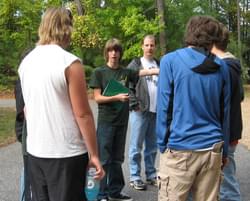




An Eagle Scout Leadership Service Project.

By Sammy Beck, Boy Scout Troop 207, Portsmouth, VA
The Lake Ballard Trail is the "main highway" at Hoffler Creek Wildlife Preserve. The Preserve is the last parcel of wilderness in the Hoffler Creek watershed in the Portsmouth, Virginia area.
The trail was once a high-traffic walking trail until a Nor' Easter in November of 2009 wiped out a section of trail which causes frequent flooding of that area. This is a major inconvenience to the staff because they can't get their golf cart or any other pieces of equipment past that point. It is also an inconvenience to visitors because it is nearly impossible to get around the mud and ruts when walking the trail.
For my Eagle Scout Leadership Service Project I decided on a repair project for the Lake Ballard Trail. Thie project goal is to fill in the damaged part of the trail with finely crushed stone called "Crusher Run" which will provide a stable walking surface. It will also provide a good drainage system which will allow water to pass through it smoothly, instead of washing out and taking the material with it.
My project will benefit the hikers and nature-watchers, who have trouble walking on the trail because the surface is very uneven, and it floods and becomes muddy after a rainstorm. It will also benefit the staff of Hoffler Creek who are unable to travel beyond that section of trail due to the floods and mud. The wildlife will also benefit by keeping the visitors and hikers on the trail instead of detouring into their natural habitat.
The Ballard trail encircles Lake Ballard, and is about 1 mile long. The section of the trail I am going to repair is located next to the second entrance to the Riparian Trail. It is approximately 54 feet long. I have decided to use crushed stone to fill in the various ruts and the major dip in the trail. The trail dips gradually along the 54 feet and is about 14 and a half feet wide.
The damage to the trail was caused by a severe storm in November of last year, which washed away most of the pre-existing components of the trail. The trails are too narrow for the large truck to travel directly to the Lake Ballard Trail, so the material will be transported to the site from the parking area using a smaller piece of equipment, a Wacker Neuson compact loader, which will be brought to Hoffler Creek on a trailer.
As the material is delivered to the site, I will have 5-6 scouts spread the material with heavy rakes. After the area is sufficiently filled and the material spread, a compactor will be used to compact the material which will stabilize the trail. The compactor will be operated by an adult, after being given operating instructions by Mr. Sutton, the owner of Area Equipment Rentals and Sales, who loaned the machinery for the project.
The compact loader and the backhoe brought the material to the repair site. I directed the drivers where to dump the material. I kept watch to make sure that material was distributed evenly along the trail. If dips or high spots were noticed, I directed the workers to level the areas using the bow rakes.
In the interest of time and labor, the Wacker Neuson vibrating plate compactor was replaced by a John Deere backhoe. Due to the backhoe's mass and the size of the trail repair, it could easily compact and compress the crushed stone more efficiently than a plate compactor could. It also had a bucket, so more material could be taken to the repair site which made the project go faster.
After the trail repair was completed, there was an amount of about two and a half compactor buckets of left over material. I asked Mr. Ted Miller, the weekend manager, if there were any other areas at the park that needed to be filled. He showed me a small dip next to the office where water pooled during a rain. I enlisted 2 scouts for the job of shoveling and raking to level the area. The rest of the material was donated to Hoffler Creek, and Mr. Miller was very happy to have it on hand for future repairs. I instructed to driver of the compact loader to dump the remainder of the material behind their shed, next to the main office.
Hoffler Creek was very pleased with the repair to the Lake Ballard Trail and were also very happy to receive the various tools, tarps, and the remaining material, which were donated to them at the end of the day. The scouts were also proud of their work, and I was as well.
For more information on the trail and preserve:
The Foundation’s mission is to conserve the last parcel of wilderness in the Hoffler Creek watershed for environmental education, research, and recreation consistent with good stewardship. The primary objective is to provide a variety of activities that promote individual awareness of and sensitivity to the natural resources of the Hoffler Creek watershed and the greater environment.
Hoffler Creek Wildlife Foundation
4510 Twin Pines Road, Portsmouth, VA 23703
Phone (757) 686-8684
www.hofflercreek.org
[email protected]